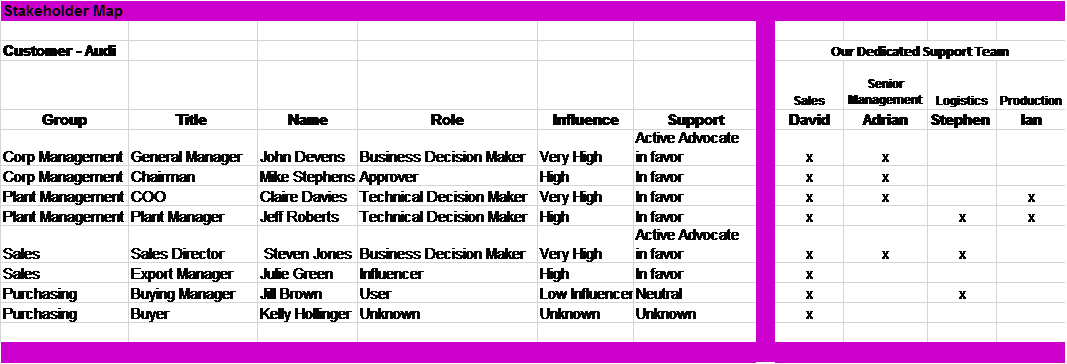Four Keys to Consistently Grow Your Global Key Accounts

Key Account Management is more critical than ever for two main reasons.
Firstly, because fewer customers represent a larger share of your sales, and
Secondly, your efforts to grow and expand your business hinge on your best people learning the skills needed to succeed in this complex environment.
So why is Global Account Management challenging?
It's more complex in size and scope involving multiple stakeholders and attracting heavier competition.
Additionally, many organisations' struggle to implement and enforce global strategy on a local basis. The local centres often have P&L responsibility and a lot of power, and it's not uncommon to be dealing with founding owners that have been acquired. They frequently have different markets, strategies and agendas all of which can knock your strategy off course.
With this backdrop, what are the keys to successfully managing key accounts?
Here are four keys that help to drive consistent success on a global scale.
- Building Consensus - Endeavour to build a consensus of agreement with the local CEO, CTO & CFO. Do that by trying to understand the relative local business priorities. You may not achieve complete consensus but rather a long way towards it. So, for example, is their priority reducing cost, avoiding risk or increasing speed? This understanding of the local situation is vital as you must come to a balance where each of the local countries can deal with the strategy. Once this type of baseline agreement is signed up to, it forms the basis for change. And it really helps focus the mind, fosters debate and allows everyone to move forward with relative consistency.
- Beware commoditization - For many of these local countries, there is the constant pressure to reduce cost and increase speed. The temptation is to move into a commoditized mode where you simply create and deliver your product or service in a 'manufacturing style'.
And that's a dangerous position because so many people do provide a good basic service.
So, if you are drawn into providing a commodity you can very easily be beaten by a competitor.
It's easy to fall into the trap of not taking the time to stop and truly align with the business.
Taking this time is vital to allow you to plan how you can bring real value to the customer.
We must take the time to think how we can leverage our own organisation to bring something remarkable to the customer that will differentiate ourselves.
One key to doing this is to move from a ‘CONTENT' focus to a ‘CONTEXT' focus. Instead of focusing on your product or service, broaden your frame of reference. Think of how your solution can impact the customer's total commercial situation.
- Solution Trends - As the trend moves away from providing products and services to clients and over to the delivery of value based solutions. So, the level of complexity increases, accentuating the need for standardisation both externally and internally. For the external teams, this must allow them to focus on value-based selling and in capturing within CRM an increased quality of customer information.
Internally, there is a strong requirement for supportive processes and a dedicated aligned client team to allow for the solutions to be scalable and repeatable.
- Create a Winning Formula – Global and National key account management can get complex, so think about it a way that makes common sense and doesn’t give you a migraine!
One way is to create a formula that breaks it down into elements that you and your supporting team can act on in a consistent way.
In hospital, operating theatres, doctors and surgeons have checklists, so do military jet pilots.
But why? Since they are highly trained, intelligent professionals?
Because it dramatically reduces the failure rates.
To create world-class service levels on global accounts you need to have these checklists in place across the customer buying process at each touch point. Sales, admin-support, customer service, production, logistics and day two support and service.
Here’s one way to think about this formula:
Success = Relationship x Knowledge x Process x Integration x Value
Let’s add some detail to each of these elements.
- Relationships – Who are the stakeholders, influencers and decision makers?
Ultimately, these relationships are built on trust.
What is Trust?
Trust is their ‘buy in’. They truly believe you really understand what they are trying to achieve and want to help them achieve it.
One key factor is establishing shared values and goals from both professional & personal perspectives.
You understand their Concerns & Issues.
You know the Strategic Initiatives they are focused on delivering.
You understand their Personality Style and how they like to communicate.
To understand your customer, you need to know their:
- Organisational Chart
- Influencer Groups
- Roles & Involvement
- Buying Process
All this information will allow you to create a Stakeholder Map. (fig 1.)

Knowledge
Research the industry
- History
- Objectives
- Concerns / Problems
- Organisational Structures
- Government Regulations
- Terminology
Know the Organisation
- Strategy
- Financials
- Objectives & needs
- Priorities
- Research Sources
- Associations
- Trade shows
- Trade Publications
- Social Media
If you do your homework well this level of understanding and knowledge will enable you to provide timely insights to senior decision makers that make interacting with you a valuable experience.
Process
What is change? Fundamentally, for most organisations it involves 3 stages:
- Moving from current state (threat) through a
- Transition state (uncomfortable) to a
- Future state (opportunity)
So, we need to understand their decision-making criteria.
What’s important to them? And what is the process they go through to make their decisions.
To help us understand this process it’s good to see things from the decision makers’ perspective.
- Step 1. Awareness – Do I have a problem? Does it justify action?
- Step 2. Assessment – How should I solve it?
- Step 3. Apprehension – What if it doesn’t work?
- Step 4. Action – How do I get started?
- Step 5. Adoption – Is this working?
Integration
One of the best ways to achieve a meaningful integration is to create a mutual action plan.
Via a Quarterly Business Review Meeting discover :
How can we help and work together?
What is key to your business growth?
When does it have to happen?
Who will need to be involved?
Status – What do we need to do to move ahead? Go / No Go?
Aligning Internal Resources is Critical to customer confidence. (see fig 1.)
Move from thinking of Product.
Move to thinking of solutions.
Focus on:
- Joint Planning
- Integrated processes
- Collaborative Projects
- Business Impact
Value
Widen your perspective and see this relationship with 20 x 20 Vision.
Then you will be more aware of multiple opportunities over next 3 years, not just one current deal.
Learn to articulate your value in these key areas:
- Customer’s business objectives
- How your Solutions offer unique value
- Use EMOTION – Share Stories of other successful individuals
- Use LOGIC - Build your business case – Show Financial Justification.
- Document it & Defend it.
Using these 4 Keys you can establish a strong foundation that allows global strategy to be successfully implemented whilst respecting and developing long term customer relationships.
|